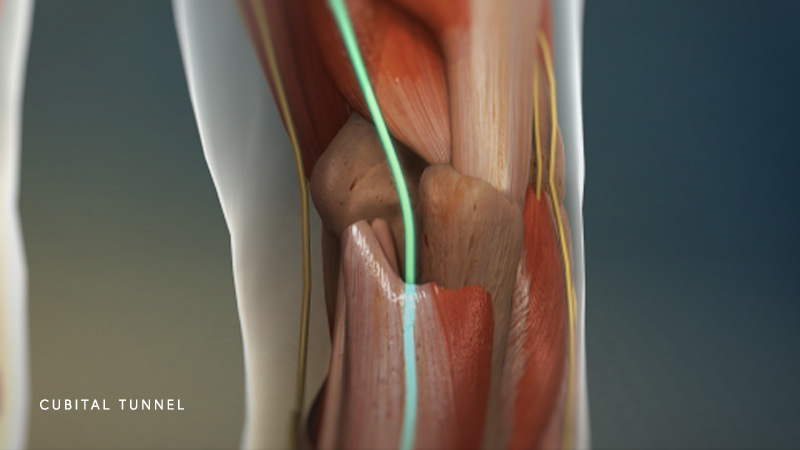Cubital Tunnel Syndrome
Ulnar Neuropathy (cubital tunnel syndrome) is a result of increased pressure on the ulnar nerve which travels from the wrist to the shoulder. The effects of this ailment are felt in the elbow, where the nerve passes close to the skin’s surface area of what is commonly referred to as the “funny bone”. This portion of the elbow derives its name from the bone of the upper arm: “humerus” bearing close resemblance to the word “humorous”.
A series of ligaments including the medial collateral ligament and lateral collateral ligament connect the humerus to the bones of the forearm (radius and ulna) allowing for extension and contraction of the forearm from the humerus. One of the ligaments is the fascia, which is involved in ulnar nerve compression. The ulnar nerve runs from the top of the shoulder down to the wrist and provides function of the muscles in the ring and pinky finger as well as allowing for the sensation of touch. All of the nerves that travel through the arm pass through the elbow. These nerves are responsible for signaling the muscles of the ring and pinky finger to work and to also relay sensations such as touch, pain and temperature. The compression of the ulnar nerve alone is responsible for cubital tunnel syndrome.
Cubital tunnel syndrome is the result of the ulnar nerve being progressively compressed or having too much pressure on it. The ulnar nerve can often become compressed in this region due to the narrowness of the tunnel through which the nerve passes. There is very little soft tissue to protect the ulnar nerve.

Cubital tunnel syndrome is often caused by prolonged bending of the elbow at a 90-degree angle. Repeatedly bending the elbow, sleeping with the elbow bent, prolonged leaning on the elbow, and bone spurs are all causes of cubital tunnel syndrome. In its totality, cubital tunnel syndrome is the result of a compressed ulnar nerve or a fractured or dislocated elbow.
The most common symptoms of cubital tunnel syndrome include numbness and tingling of the ring and pinky finger, especially when the elbow is bent. Hand pain, weak grip, and aching pains on the inside of the elbow are also common symptoms. The symptoms of cubital tunnel syndrome may also resemble other medical conditions such as medial epicondylitis (golfer’s elbow). This is why it is important to get a diagnosis from a medical professional.
Physician’s will conduct a full medical exam in order to rule out various other medical conditions or problems and determine the root cause. In addition to referencing the patient’s medical history, physicians will also run a series of diagnostic tests that include:
Nerve Condition Testing
This test pinpoints how fast signals travel down a nerve in order to find a constriction or compression of the nerve.
Electromyogram
The use of this test is to check nerve and muscle function. This test may also be used to test the forearm muscles controlled by the ulnar nerve. If the forearm muscles are not functioning properly, it may be an indication of problems regarding the ulnar nerve.
XRays
XRays are done to check patients for bone spurs or arthritis that could have a direct impact on symptoms.
The most effective treatment for cubital tunnel syndrome is ceasing all activities that could be causing the problem. However, there are a variety of treatment options available including:
- Wearing a splint or foam elbow brace at night to limit movement and bending of the elbow
- Using an elbow pad to protect against chronic irritation from resting the elbow on hard surfaces
- Anti-inflammatory medications such as ibuprofen or naproxen
- Nerve gliding exercises
- Steroid injections to reduce swelling and pain
- Surgery.
Seeking Treatment
If you are currently experiencing symptoms of cubital tunnel syndrome, or have been given a diagnosis and require treatment, contact the Center for Orthopaedic Specialists today! Our experts would be happy to treat you.




 / 50 Reviews
/ 50 Reviews